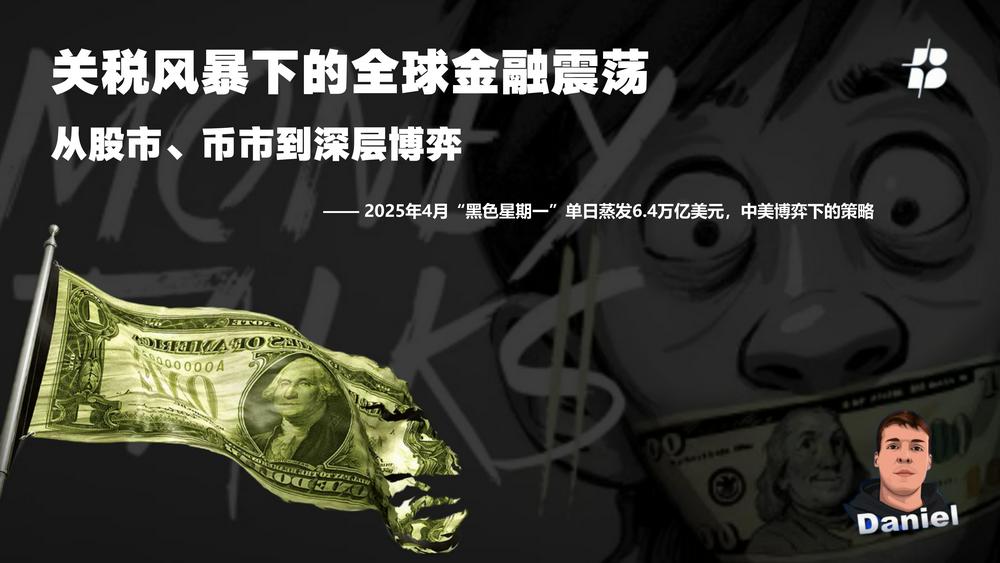Global financial shocks under the tariff storm: from stock markets, currency markets to deep game

Reprinted from panewslab
04/09/2025·1M
1. Events ignited: How tariff policies "strangle" the global market
1. Policy shocks and market plunge
- US stocks collapse: After Trump announced "reciprocal tariffs" on April 3, the three major U.S. stock indexes plunged collectively, with the Dow Jones Industrial Average falling by 5.5% in a single day, the S&P 500 falling by 5.97%, and the market value of the "Seven Sisters" of technology stocks evaporated by more than US$505 billion;
- A-shares followed: On April 7, the three major A-share indexes opened lower by more than 4%, while the ChiNext Index fell by 6.77%, and market panic spread;
- Cryptocurrency fell sharply: Bitcoin fell below $83,000, Ethereum plummeted 10%, and MEME coins on the BSC chain were generally cut in half;
2. Global assets fell without differences
- Commodity market: WTI crude oil fell below $60 per barrel, hitting a new low since 2021; gold safe-haven properties failed briefly, and spot gold fell below $3,000 for a time;
- Exchange rate fluctuations: The yen rose by 1% due to safe-haven demand, and non-US currencies such as the Australian dollar and the euro collectively depreciated;
2. Deep logic: Trade War 2.0 and market pricing reconstruction
1. History repeats itself? Smut-Holly 's Ghost of Tariff Act
- The Smut-Holly Tariff Act of 1930 triggered a global trade war and led to the Great Depression. Now Trump’s “reciprocal tariffs” cover all trading partners, with a tax rate of up to 49%, and the risk of global supply chain breaks surges;
- Inflation spiral threat: 97% of the United States' clothing and footwear rely on imports, UBS estimates that the prices of daily consumer goods may rise by 10%-12%, and low-income families are the first to be affected;
2. The "triple decoupling" of Sino-US game
- Trade-Tech-Financial Progressive Pressure: Everbright Securities pointed out that tariffs are only the beginning, and subsequent technology blockades (such as AI chip export restrictions) and financial sanctions (delisting of Chinese stocks listed in the US) may follow;
- China's response logic: Huatai Securities analyzed that China's policy toolbox is sufficient, with the reduction of reserve requirement ratio, consumption stimulus, infrastructure investment may become the main hedge force, and the strategic position of domestic demand has been improved;
3. The “de-risk paradox” of cryptocurrencies
- The correlation between Bitcoin and traditional risky assets (such as the Nasdaq) has risen to 0.5, losing the halo of "digital gold";
- Leverage clearing chain reaction: The high leverage position of MEME coins on the BSC chain (such as 20 times) is in batches after the price fluctuates by 5%, exacerbating the sale;
3. Trend prediction: Structural opportunities in the storm
1. Short-term market path
- Key nodes: Tariffs officially take effect on April 9 and China's countermeasures are implemented on April 10. If negotiations are not restarted, US stocks may fall by 5%-10% again;
- Opportunities for cryptocurrency rebound: If BTC stands firm at $80,000, MEME coins may rebound with the popularity of the community, but we need to be wary of regulatory crackdowns (such as the Trump family token incident);
2. Medium- and long-term asset allocation logic
- Safe-haven assets: gold (targeted at $3,100), yen and Treasury bond ETFs (such as TLT) are still safe havens for funds;
- Counter-cycle track:
Consumption and infrastructure: With the efforts of China's domestic demand policies, leading home appliances and building materials (such as Midea and Conch Cement) may benefit;
Technology independence: Domestic chips (SMIC) and AI models (Baidu Wenxin) have received policy preferences, and valuation repair is expected;
- Reshaping of cryptocurrency value:
RWA track: annualized returns of tokenized US bonds (such as Ondo Finance) and mortgage lending (Maple Finance) exceed 4%, attracting institutions such as Grayscale to increase their positions;
Layer2 technology dividends: Ethereum Pectra upgrades or activates staking demand, and tokens such as ARB and OP are rising by 50% in the medium term;
4. Investor strategies: defense, hedging and left-side layout
1. Defensive operation
- Reduce positions in high volatility assets: clear up MEME coins and technology stocks, retain 20%-30% cash or stablecoins (USDC, DAI);
- Option protection: Buy BTC put options (exercise price $75,000), Nasdaq ETF put options (exercise price is 10% lower than the current price);
2. Hedging and arbitrage
- Cross-market arbitrage: long gold/short crude oil (historical volatility difference expands to 30%), long yen/short AUD;
- A/H shares have a premium convergence: increase holdings of low-valuation blue chips in Hong Kong stocks (such as Tencent and Meituan), and the game funds are flowing back;
3. Layout Opportunities on the Left
- Bitcoin fixed investment: Buy in batches in the range of US$76,000-82,000, with a long-term target of US$180,000 (Galaxy forecast);
- Policy beneficiaries: sectors such as environmental protection (carbon neutrality subsidies), military industry (geographical tension) may strengthen against the trend;
Conclusion: Finding certainty in uncertainty
The tariff storm in 2025 is not only a pain of globalization, but also an opportunity for asset revaluation. History has proved that trade protectionism will eventually backfire itself, and technological revolution and policy wisdom are the key to breaking the deadlock. Investors need to abandon the fantasy of "quick victory theory", capture structural dividends in defense, and wait for dawn in the eyes of the storm.



 jinse
jinse